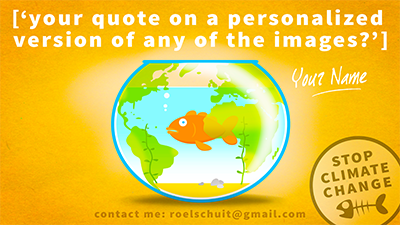 >Tweet
>Tweet
FISHBONES is an animated short I made out of the frustration I felt (and still feel) over not doing enough about something that will have a huge negative impact on the lives of my children: Climate Change.
It started out as a one-person operation, but has since grown into an international project. I produced the English and Dutch version of the animation myself, but got voice-over contributions from around the world for other languages. The Spanish version, for instance, came all the way from Chile. I got a version from Norway, from France, and there are a couple of other languages in the pipe-line.
I'm looking to create versions of the Fishbones animation in as many languages as possible. And we'll do this together. You, me, the fantastic people that went before you, and the fantastic people that will come after you.
Is your language not yet represented amongst the others here? Are you able to make a recording or do you know somebody who can? Contact me, at: roelschuit@gmail.com, and we'll make it happen!
Downloads
The images below are free to use unaltered in a non-profit way to serve environmental causes.
Choose your resolution (size of the image), then right-click on the image that appears, and select 'save image as'.
If you use one of these images outside of the internet, I would love it if you could send me a photo of where it ended up. (If you used it in print, on a t-shirt, in a magazine, on a protest sign, or anything like that, always choose the highest resolution download. For the internet any resolution will do). If you want a personalized version of any of the images, scroll a bit further down below the images.
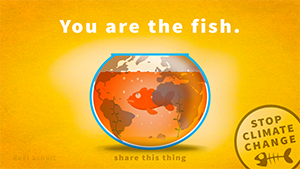 |
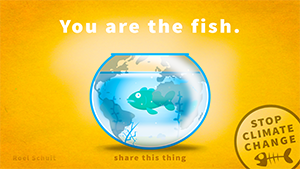 |
||||
 |
 |
 |
 |
 |
 |
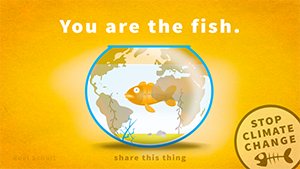 |
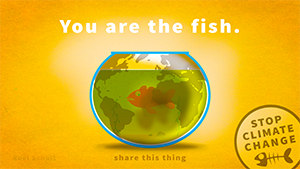 |
||||
 |
 |
 |
 |
 |
 |
 |
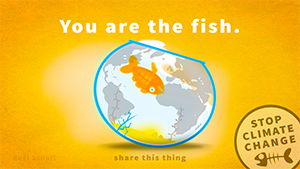 |
||||
 |
 |
 |
 |
 |
 |
 >Tweet
>Tweet
Your personalized version of one of the images?
Got a quote you'd like to see on one of the images? Send me the quote by email (roelschuit@gmail.com), as well as your full name that will appear underneath it.
The quote has to be yours and will be your responsibility, on account of copyright issues (your name will be attached to it). And obviously the text should have something to do with climate change. Once implemented, I'll send you the image with your text on it. The quote will stay yours, the image mine. Both of us will be free to use the result in a non-profit way, unaltered, to serve environmental causes.
One final condition: the offer is 'time-permitting'. I need to have time to implement your quote. That's simply because I'm not earning any money with these activities, and my time is as limited as anybody's, I think you'll understand.
Action
Obviously one animation is not going to stop climate change. But taking meaningful action against climate change does start with communicating the problem. It is the only way to get more people involved in working on possible solutions.
And that is the purpose of the Fishbones animation: it is an awareness initiative. This website, in turn, takes the next step: it is meant to contribute to the exploration of ways to combat climate change. The final step is up to you: actually taking action as an individual. Which is a lot easier and more effective than you might expect.
Let me explain.
Basically the cause of man-made climate change comes down to the consumption of stuff and food. Both because the production of it demands so much energy, pollutes in it's own right, with the actual use and throwing away after again adding to the pollution. Most energy is generated through the burning of fossil fuels, like oil, gas, and coal. Burning fossil fuels releases tiny heat-trapping particles in the air causing global temperature to rise, which, in turn, causes Climate Change.
So what can we do as individuals?
5 simple things:
- Eat less meat (I'll go more into detail in the next section 'more info')
- Use less electricity
- Waste less food
- Buy less stuff
- Use your car less
That's just a couple of things we can do right away in our daily lifes that will have an impact. And it will actually really make a difference. For instance, if all citizens of the US would take meat off the menu just one day per week, the effect on the environment would be equal to taking 19,2 million cars off the road in the US for an entire year.
Buyers' choice
Everybody making a couple of changes in their own personal life will reduce the impact of climate change, but by itself won't stop it. Rather, combating climate change should rely on a combination of things. For instance, it has to be accompanied by a change in the way energy is produced. Energy production must move from our current polluting means of burning fossil fuel to a sustainable one, using solar, wind, and other sources of green power.
And once more there's an important role for individuals to make that happen. You see, we are consumers, and if we stop buying something, it will no longer be sold. It's that simple. And conversely, if we signal we'd like to buy another product, like green energy for example, you can bet energy producers will jump in to sell it to us. Because this process is all about money. Our money. And we can use our freedom to choose what we spend our own hard-earned money on to direct the markets, and the way the products we consume are produced. Believe me, people who've got something to sell will listen to you and adapt to what's important to you. Because they want your money.
Technological solutions
Finally, a solution for climate change should include developments in science and technology. Obviously the way we produce clean energy should become much more efficient to replace the quickly depleting fossil fuels. But much attention should also be given to the way we produce our food, for instance. Because climate change is already having a negative impact on global food production levels. And this will only increase. So we should invest in finding ways to increase our food production in a way that isn't decreasing the next harvest at the same time, as is the case with current polluting mass production methods of growing staple food like wheat, maize, rice, and other grains to feed our still sharply rising world population.
We, the people
Yet again attention for scientific and technological research funding is something we as individuals can initiate. The sad truth is most people in powerful positions who can make all this happen won't do so unless we tell them to. That's because most leaders (be it in government or commerce) are not really leaders, they are followers. They simply follow public opinion to stay in their powerfull positions. That means we, the general public, must lead the leaders. And we can do so by stating our concerns about climate change, in public, and often.
Go forth and multiply
The Fishbones animation is a tiny contribution to do just that. It is meant to inform people about the subject of climate change, and to provide others with a means to inform still other people. Ultimately to move the people with large-scale power to take firm action against climate change. And we can do that. Because, as we now know, we have much more power and influence as individuals ourselves then we tend to think.
We can change things that bother us. Even big things, which might sooner cause us to despair, when really we shouldn't. We can get this fixed. And I'm asking you to work with me on that. Starting by either sharing this video, or by making your own (or both, the more voices the better!). Or by sharing its message by any means that works best for you. But we need to do this. We need to stay on top of climate change, before it is on top of us.More info
This video is meant to illustrate the dangers of Climate Change in a simple and accessible manner. To inform people about a very real and urgent threat to our own well-being in the immediate future, the future of our children, that of our grandchildren, and so on.
Climate Change isn't really about the average temperature rising a bit on a global scale. It's about changes in weather patterns of our planet that result from it. It is about how habitable our planet is for us. In other words: how comfortable or how difficult life will be for us living on it.
But why do a couple of degrees warmer matter so much?
When we talk about 'climate', we basically talk about stable weather patterns that can be observed over a long period of time for a given area (big or small, making it global or local climate). And what has been observed, is that global temperatures are rising on average, since we started developing large scale industry not much over a hundred years ago. And this rise in global temperatures can indeed be irrevocably linked to human-caused pollution: when you find rising quantities of tiny heat-trapping pollution particles over time, you see temperatures rising as well. It kinda makes sense.
The rising temperatures have all kinds of effects. The one that has probably gotten the most attention over the years is the melting of our icecaps. Melting icecaps causes our sea-levels to rise. And this is a direct threat to our world's densely populated low-lying coastal areas, with its many coastal cities that house a huge part of our global population.
But this is only one of three important undesirable situations that are currently unfolding and intensifying due to climate change. And all of them have to do with
the seemingly insignificant rise of global temperatures by a couple of degrees. Here they are:
- Changing weather patterns strain and threaten global food production.
- The extra water of our melting ice caps threatens to submerge our heavily populated coastal areas.
- Increasing frequency and severity of freak weather events threaten lives, rake up huge costs in material damage, and, again, threaten food production.
What's for dinner?
Of the three undesirable situations distinguished above, I feel the decline in food production is a somewhat under-exposed effect of Climate Change in the general media. Everybody knows the images of a lone polar beer on a piece of melting ice in the ocean. But I wonder how many people realize the food on their table comes into the picture with climate change as well.
Melting icecaps cause sea levels to rise, flooding our coastal areas. And that simply leaves us with less available land to produce food on. But as if that isn't enough, certain parts of our coastal areas (river deltas, for example) are amongst the most fertile lands on our planet. That's a double whammy.
So the picture of a polar beer standing on a melting sheet of ice clearly involves more than simply calling for the preservation of the habitat of a deceptively cuddly looking animal. It is not just her feeding grounds that we destroy by not keeping climate change in check. It's our own as well.
Goldilocks
Unfortunately, the effect of climate change on food production doesn't end there. Food production depends on stable conditions of quite a few variables. And there is a real Goldilocks aspect to it. Too warm or too cold, too much rain or too little, too many insects (pests) or too little (pollinators), not the right kind of topsoil, and our food won't grow. Change one variable, and we might loose our entire harvest.
That is in fact exactly what's happening due to rising temperatures: conditions are changing.
With global temperatures a couple of degrees warmer, the rainfall you might normally expect and need for your crops to grow, might have suddenly shifted to a couple of weeks earlier. Or later. Or disappeared altogether. Without the right amounts of water at the right time, your crops won't grow, or not enough.
And you can't just change the timing of your crop seasons either, to coincide with one changed variable. Because then the other variables might be out of check. You might, for example, have enough rain if you plant your seeds earlier, but caterpillars won't polanize the plants that grow our vegetables, while butterflies will. In fact, caterpillars eat our plants, so we'd better try to make sure Nature's cycles aren't disturbed too much, if we want to eat.
Freak weather events
Climate change also coincides with freak weather events. One early morning of heavy frost when the blossoms are already out and you'll have no fruits from the affected trees that year. One sudden storm can also ravage fruit production, by blowing the butting fruits off their branches prematurely. And it only takes one fierce downpour of hail to damaged your fruits and leave them rotting on the branches of their tree.
The same goes for the production of our main staple foods: wheat, maize, rice, and potatoes. Dry spells, heat waves, downpours, hailstorms, tornado's, and other extreme weather events all have the potential of severely damaging global food production. And unfortunately the frequency and severity of freak weather events have all gone up coinciding with rising global temperatures and climate change.
The first yield kills the field
The irony is that food production is actually a massive contributor to climate change itself. This has to do with the way we produce our staple foods. Back in the 1960s, in a well-intended attempt to combat a looming food crisis in countries like India, an ineptly-named 'green revolution' method was introduced to vastly augment food production. And initial results were stunning.
Through the use of chemical fertilizers and insecticides, imported grains from cross-bred wheat and maize species grew very fast, producing very large grains, in numbers surpassing previous harvests manyfold. In a miraculous turn-around, it changed India almost overnight from a country depending on import to feed its people, to a country actually exporting its grains. Very well-meaning people had worked very hard many years to accomplish this stunning feat of food production architecture.
There was only one problem. Each harvest caused the following one to decline. The chemical fertilizer supplement, needed to sustain the fast growth of these special cross-breed plants, at the same time started to kill the very ground the plants were supposed to grow from. That meant each harvest needed still more chemical fertilizers to feed the plants' growth, thereby accelerating the spiral of dependency on polluting chemicals. Add to that the chemicals sprayed on the fields for pest-control, and every harvest period leaves your ground more and more barren, with less and less plentiful yields. Making it really not a 'green' revolution, but a chemical one.
One way to compensate for the decline, was to drastically kill all competition the plants could suffer. Enter herbicides. To prevent your own plants from getting killed by the same poison, new techniques were used that eliminated the grow-cycle traditionally needed to select and crossbreed wheat and plants to create other versions of existing ones. Versions resistant to poison, for example. Through genetic engineering.
Chemical food
Building upon humanity's extraordinary collective heritage that created wheat and plants whose seeds through centuries of human selection and cross-breeding are large and numerous enough to ensure a daily meal from harvest to harvest, large chemical companies started to dabble in the production of food as well. Using yet another extraordinary feat of collective human endeavor, the science and technology of genetic engineering, they turned our seeds into plants that withstand the primary product these chemical companies sell: poison. Chemical herbicides to kill plants and herbs that vie for the same spot under the sun and same nutrition in the ground (or the chemical fertilizers dumped on it). Thus the Chemical Revolution was complete.
Of course, this strategy to halt the decline is yet another example of short term gains that delay and augment the real problem. Adding chemical herbicides to chemical fertilizers and chemical insecticides only kills the ground ever faster. And before long, the ground only serves to keep the roots of the plants into place, and chemical fertilizers uniquely provide all nutrition for the plants to grow.
An equilibrium still, you might think. Yes, but one that poisons the people working the ground at the same time, as well as the people eating the products. And even people not working the grounds, but living aside downstream rivers that transport the chemicals away from the fields, are affected by it. And finally all people in the surrounding area drinking, cooking, and cleaning with water from poisoned wells by the equally poisoned ground water are all poisoned as well. And water is exactly the reason why even an unhealthy equilibrium of dead ground and sufficient chemical fertilizers for growth is not a real equilibrium.
Cup of dust
Water is one aspect of this chemical food production process that I haven't gone into yet. It is the final nail in the coffin of any notion of long term benefit from the inappropriately named "green revolution" method. And in fact, the original well-intended solution to food shortage was never presented as a long term measure. Yet we are still using it as such. All the while simply post-phoning, and actually intensifying, the problem.
Especially when chemical companies took over. Here's why: the cross-breed and genetically modified plants need enormous amounts of water, next to copious amounts of fertilizer. Much more than most environments can offer. So much, in fact, that all over the world vast groundwater planes that formerly sustained agricultural activity are heading for quick depletion. That means that even if a poisonous equilibrium of decreased but seemingly stabilized food production is reached through this chemical method, water shortages will further decline harvest yields. It also means people have nothing to drink.
The real green revolution
Still, we need to eat. Our World's population is growing, and food production can't keep up. So how can we produce our food in such a way that nobody goes hungry, while at the same time eliminating--or at least cutting down on--pollution and water shortages? Well, for starters, about 20%-40% of all food produced is never eaten. It's wasted. Wasted during transport, wasted because people buy too much food, wasted because people throw away left-overs that could perfectly well be served again the next day.
So there's a lot to be gained here. But food needs to be produced in a less-polluting way as well, if we are to stop the decline in growth of our global food production as a whole. I've got nothing against genetic modification per sÚ, but, as with everything, you have to be careful how you apply it. If you use it to create a mono-culture food production system that depends heavily on chemicals to sustain itself, than one mutation in plant decease could wipe out your entire harvest with no backup. Also, a solution shouldn't add to the problem, like the large scale pollution of the chemical revolution did. And maybe we don't even have to hop from short term solution to short term solution, always pushing the real problem ahead of ourselves, making it worse.
It turns out that diversified planting actually ups the harvest, because it provides natural and diversified protection against pests. It also turns out that if you treat the topsoil well, not exhaust it, and certainly not kill it, it yields harvests outweighing current chemical food production. Without the pollution. And without exhausting our water supply, since many endemic plant species require less water.
Meat your maker
But we do not only eat wheat, or maize, or vegetables, or any other plant-based food. Most people also eat meat. And meat production is actually even more polluting than the other food sources. For one thing, it includes a big part of the production of the other food sources. To feed the animals. The first advantage of reducing meat consumption is that part of the land we now use to grow food to feed a staggering amount of animals for meat production, can also be used to feed ourselves.
Most meat you'll find while shopping for groceries, is not from animals who spend their lives in idyllic pastures. Instead, these animals are kept locked in slots inside stables where everything is optimized to produce the most meat at the lowest cost, and as fast as possible. Animal well-being is considered part of the overhead costs, and cut whenever possible. This is partly because there are people who want to make as much money as possible no matter who's paying the price. And partly because customers don't want to pay the real price for meat.
Primary customers of meat are large scale vendors such as your large surface grocery shop. There's a couple of more steps in between, but if you put meat on the table, you're the last in line. That means you've got to foot the bill.
And even though meat might represent a significant part of what you pay when you check out in the grocery store, if you think about the line of people that need to get paid with that money, it can't possibly be sufficient. And it actually isn't. Most governments pay the rest of the bill, in the form of subsidies. So in the end you actually do pay the bill, indirectly, through your taxes. But still it's not the entire costs that are covered. Animal welfare is not included in the prices, and neither is the industry's negative impact on the environment. Which brings us back to our initial topic.
Killing you softly
To feed the locked-in animals in their stables, forests are cut down and replaced by chemical corn or wheat fields, depleting our groundwater and polluting acre after acre. It is really like driving in the wrong direction: you're getting further away from where you want to be. Because forests actually clear pollution, instead of adding to it the way chemical corn fields do.
As for the cows, sugar-rich corn or wheat is not even appropriate food for cows. But here's the real problem: even if you feed cows proper cow-food (which is grass), they still produce methane in large quantities, already naturally. It's how their digestive system works, with farts and burbs.
Unfortunately, our global demand for meat is so great, that the amount of methane in the atmosphere produced by cows creates more pollution than us driving our cars. That is because methane particles are much better at trapping heat than your average pollution particle. Thus contributing to a surprisingly larger extend to climate change than cars do, after all the media attention car pollution has gotten. It explains why eating less meat has such an impact when combating climate change. Unless you want to get killed by farts.
A warm farewell
I want to return to the subject of our icecaps one more time, before they are completely melted. Because this situation may have more consequences than rising sea-levels and loss of land alone. You see, our icecaps consist of fresh water, which is melting in unimaginable quantities into salt water oceans. Fresh and salt water do not mix very well, because of differences in density, and that changes how water in our oceans behaves when the two meet. The same goes for warm and cold water, with the latter being more dense.
The behavior of the water in our oceans is also influenced by the gravitational pull of the moon, which causes what we call the tides. And finally by atmospheric wind conditions. Wind is caused by turbulance when warm and cold air meet (coastal areas offer great examples of this), with warm air being less dense, just like with warm and cold water. But wind is also caused by the Earth's rotation.
The Earth turns on it's axis, and that influences the movement of the air surrounding it. Anybody who has ever walked with a cup or glass filled close to the rim with something to drink, has experienced that less solid things follow motion more slowly than the solid cup or glass in which they are transported. Scourging hot coffee is especially good at reminding you of that. Hot coffee also shows you that the steam rising from it trails motion even more.
And so it is with the air of our planet's atmosphere. It follows the movement of the Earth, but somewhat more slowly. And because our turning Earth is round in form, all kinds of turbulant curly motions in our atmosphere are the result.
Air turbulance (moving air) is what we call wind. And wind influences the movement of the water it blows over, thus creating surface currents. Surface currents create deep water movement, and that covers just about all currents there are.
Because there exist relatively stable patterns of prevailing strong winds in our atmosphere (the bigger ones even got their own names, and go by 'Trade winds' and 'Westerlies'), there also exist relatively stable currents in our oceans. The precise route these currents take is further influenced by the resistance they meet in our landmasses, underwater obstacles like the ocean's floor, and the before-mentioned motion of the tides and differences in density due to temperature and salinity. All these influences together cause relatively stable currents to arise, big enough to transport large quantities of water from one place to the other. And one of the more influentials ones is called the Gulf stream.
The gulf stream transports warm water from equatorial areas on a trans-Atlantic voyage towards the coasts of western Europe, as one of its destinations. If you take a map, and draw a horizontal line from, say, France to the left across the Atlantic ocean, you touch land again somewhere on the border between the United States and Canada. I think you'll agree France's wheather is nicer than going up north in North America. That's how effective the gulf stream is at transporting heat. And this goes for most of Western Europe. Until it doesn't.
Many Devils in the details
Should the routes of our oceans streams change, their heat and cold distribution over our planet will change as well, plunging Western Europe in Canadian wheather, potentially. That would have dire consequences for food production as well, with areas well suited for agriculture suddenly bringing in meager harvests, or none at all. Conversely, other places where the gulf stream could shift to, might become more suitable for food production. Better temperatures, yes, but not necessarily the right amount of water at the right time, or the right topsoil for food production, etcetera. Some of these areas now suitable for food production, might actually become too hot. Changes like these bring different situations, not necessarily better ones. In fact, more likely not.
Some things should never change
Basically, when it comes to climate, your grandfather was right when he told you things where better back when he was young. Changes in general are often good, even necessary, or at least interesting. But some things shouldn't change too much. Like your favourite tv show. Or chocolate. And our climate takes the top spot. Because that's all about how comfortable or how difficult life is for us, even if not everybody realizes it yet. And that's one thing that should change. And it will, thanks to you, me, many others, and soon many more. So let's do this!
top
facebook | roelschuit@gmail.com |
youtube
Share on Tumblr |
submit to reddit | Tweet this thing
Disclaimer : the information presented here is a summary of the main things I have learned about climate change. As scientific knowledge on this subject expands, so will the content of this website adapt. I am not a climate scientist myself, so please correct me if I misrepresent any of the findings environmental science has produced. I do not wish to be wrong any longer than I need to.









